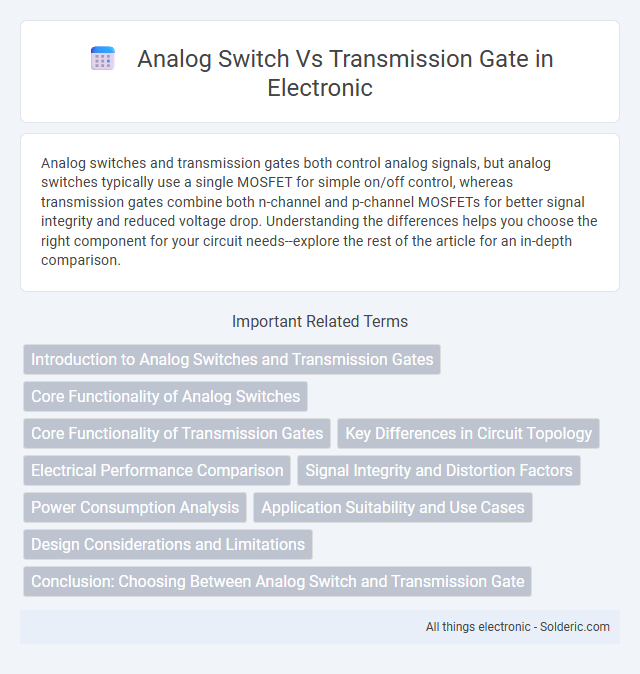Analog switches and transmission gates both control analog signals, but analog switches typically use a single MOSFET for simple on/off control, whereas transmission gates combine both n-channel and p-channel MOSFETs for better signal integrity and reduced voltage drop. Understanding the differences helps you choose the right component for your circuit needs--explore the rest of the article for an in-depth comparison.
Comparison Table
| Feature | Analog Switch | Transmission Gate |
|---|---|---|
| Structure | Single MOSFET (NMOS or PMOS) | Complementary MOSFET pair (NMOS + PMOS) |
| Signal Pass | Passes only strong '1' or '0' | Passes both strong '1' and '0' signals accurately |
| On-Resistance | Higher and voltage-dependent | Lower and more constant across signal range |
| Voltage Swing | Limited by threshold voltage drop | Full rail-to-rail voltage swing |
| Applications | Simple switch applications, low-speed multiplexers | Precision analog switches, sample-and-hold circuits |
| Control Complexity | Single control signal | Complementary control signals required |
| Leakage Current | Higher leakage possible at off state | Lower leakage due to complementary structure |
Introduction to Analog Switches and Transmission Gates
Analog switches and transmission gates are fundamental components used for signal routing in analog and mixed-signal circuits, enabling controlled connectivity between input and output nodes. An analog switch typically uses a single MOSFET transistor to pass signals, while a transmission gate combines both NMOS and PMOS transistors to provide low on-resistance and bidirectional signal flow. Transmission gates offer improved linearity and lower distortion compared to single MOSFET analog switches, making them preferred in high-performance analog applications.
Core Functionality of Analog Switches
Analog switches control the passage of analog signals by acting as electronically controlled on-off gates, enabling or blocking signal flow. Unlike simple switches, transmission gates combine both NMOS and PMOS transistors to reduce signal distortion and provide low-resistance paths for bidirectional signals. Core functionality emphasizes minimal signal degradation, low charge injection, and the ability to handle a wide range of voltages while maintaining high linearity in analog circuits.
Core Functionality of Transmission Gates
Transmission gates serve as bidirectional switches that efficiently pass both logic high and low signals with minimal voltage drop, utilizing complementary MOSFET pairs to reduce signal distortion and improve switching precision. Unlike simple analog switches relying on a single transistor, transmission gates combine n-channel and p-channel MOSFETs, ensuring low on-resistance and symmetrical conduction for analog and digital signals, which enhances your circuit's accuracy. This core functionality makes transmission gates ideal for multiplexing, sample-and-hold circuits, and other applications requiring seamless signal transmission across varying voltage levels.
Key Differences in Circuit Topology
Analog switches consist of a single MOS transistor, typically implemented as either an NMOS or PMOS device, resulting in simpler circuit topology but limited bidirectional conduction and higher on-resistance variation. Transmission gates combine complementary NMOS and PMOS transistors in parallel, enabling low on-resistance across the input voltage range and true bidirectional current flow, making them suitable for analog signal multiplexing. Your choice depends on the trade-off between design complexity and performance requirements in analog switching applications.
Electrical Performance Comparison
Analog switches typically exhibit higher on-resistance and greater voltage drop compared to transmission gates, which combine NMOS and PMOS transistors to minimize these issues. Transmission gates provide better linearity and lower distortion, making them ideal for high-precision analog signal routing. Your choice impacts signal integrity, with transmission gates offering superior electrical performance in switching applications.
Signal Integrity and Distortion Factors
Analog switches often suffer from higher signal distortion due to their unidirectional conduction and nonlinear on-resistance, which can degrade signal integrity especially at high frequencies. Transmission gates, combining both NMOS and PMOS transistors, provide symmetrical conduction paths that minimize signal distortion and maintain better voltage swing, enhancing signal integrity across a wider frequency range. The complementary architecture of transmission gates reduces charge injection and feedthrough effects, key distortion factors commonly observed in single MOSFET-based analog switches.
Power Consumption Analysis
Analog switches generally consume less power in steady-state conditions due to simpler transistor configurations, making them suitable for low-power applications. Transmission gates, utilizing complementary MOSFETs, offer better signal integrity and reduced distortion but can introduce higher dynamic power consumption during switching transitions. Your choice between the two should balance power efficiency with signal fidelity based on the specific requirements of your circuit design.
Application Suitability and Use Cases
Analog switches are ideal for low-voltage signal routing and simple ON/OFF control in audio, video, and data acquisition systems due to their single MOSFET structure that provides fast switching and minimal signal distortion. Transmission gates, combining NMOS and PMOS transistors, excel in bidirectional signal transmission and offer low resistance with minimal voltage drop, making them suitable for analog multiplexers, sample-and-hold circuits, and precision analog signal path control. In applications requiring high linearity and low leakage across a wide voltage range, transmission gates outperform analog switches, especially in mixed-signal ICs and integrated sensor interfaces.
Design Considerations and Limitations
Analog switches offer simple design with lower complexity and limited control signals but face limitations in on-resistance variability and signal distortion at higher frequencies. Transmission gates, combining MOSFETs in parallel, provide improved linearity, reduced on-resistance, and bidirectional signal flow, enhancing performance in precision analog circuits. Your choice depends on trade-offs between design simplicity, signal integrity, and the specific analog signal requirements of your application.
Conclusion: Choosing Between Analog Switch and Transmission Gate
Selecting between an analog switch and a transmission gate depends on the application's voltage range, signal integrity, and power consumption requirements. Transmission gates offer bidirectional conduction with low on-resistance and minimal distortion, making them ideal for high-precision analog signals and CMOS technology compatibility. Analog switches provide simpler control and integration but may introduce higher resistance and signal degradation, thus favoring less demanding applications or digital signal routing.
Analog switch vs Transmission gate Infographic

 solderic.com
solderic.com